
 |
|
|
|
Some 1970s film students found themselves with an odd quest: to see dozens of overlooked, unheralded B&W thrillers that appeared on lists bearing the new term film noir. As this was well before the advent of home video, my personal first encounter with the dark, often deeply pessimistic likes of Criss Cross and Out of the Past took place on late night television. There's nothing like a doom-laden fade-out at 3am with a film's entire cast dead on the floor. I'd fall asleep haunted by the profound romantic negativity. 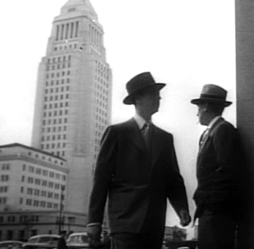
One film I caught in this fashion is 1948's Pitfall, an unrecognized classic noir that nails the soul-sickness of the new peacetime prosperity. The leading character is not a private eye but an insurance man, a 9 to 5 plodder who describes himself as being "in a rut six feet deep". We meet John Forbes on his way from his modest hillside home to work in downtown Los Angeles; Pitfall is an amazing time capsule of The City of Angels in the immediate postwar period. The story is a carefully designed domestic nightmare. In a petty rebellion against the constraints of his job and marriage, the bored John Forbes foolishly becomes involved with fashion model Mona Stevens (Lizabeth Scott). Mona's boyfriend Bill Smiley (Bryon Barr) is in prison for embezzlement; Forbes' job is to recover the expensive gifts Bill bought for her with stolen money. Trouble comes when John bends the rules and lets Mona keep part of the loot, a small boat. Hulking, maladjusted private detective MacDonald (Raymond Burr) located Mona and is harassing her for a date; he deeply resents John's cutting in. When he realizes that Mona and John have become lovers, MacDonald beats up John in his own driveway. The affair ends when Mona discovers that John is married. John returns to his loving wife Sue (Jane Wyatt) and son Tommy (Jimmy Hunt). But MacDonald doesn't let up on Mona, even when she rebuffs his advances. The scheming detective visits Bill Smiley in prison and inflames him with allusions to Mona and John's affair. When Smiley is released on probation, MacDonald gets him drunk, puts a gun in his hand and gives him John's address. 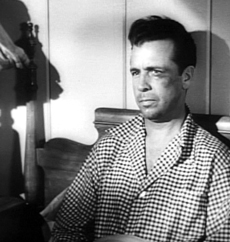
Although he thought his sins would never follow him home, John now must stand guard in the dark for a stranger who wants to kill him. What began as an ordinary thriller shapes up as a modern Young Goodman Brown or another version of Eyes Wide Shut. The difference is that John Forbes doesn't merely contemplate the consequences of temptation, he experiences them. As in Eyes Wide Shut, an innocent woman pays the penalty for his thoughtless indiscretions. The casting is very precise. Dick Powell, already an accomplished Philip Marlowe for RKO, is the cynical Forbes, forever grousing to his wife about the lack of adventure in his life and rather selfishly feeling sorry for himself. As Sue, Jane Wyatt patiently indulges John's sour comments but insists on a "real" kiss when they arrive at his office. Wyatt would soon come to represent the ideal housewife with her role in TV's Father Knows Best, and much of Pitfall plays as a dark reflection of the myth of 50s domestic harmony. Sue Forbes subtly resents her husband's idle daydreams of South Seas adventures with "dusky dames", a dialogue line that becomes ironic when we realize that Wyatt's previous cinematic claim to fame was as the exotic love interest of Frank Capra's Lost Horizon, an ultimate escapist dream story. John Forbes wants to know where the magic and adventure went. Sue sees his whining as an immature streak, to be patiently indulged. 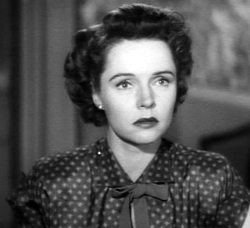
Some moralistic noirs delight in demonstrating that one "innocent" mistake will sweep an ordinary guy into a vortex of mounting jeopardy. The perfect example is the 1951 Mickey Rooney film Quicksand. The message is simple: keep your nose clean, or this could happen to you. John Forbes is more like Al Roberts in Detour in that his mistakes stem directly from his personality. Feeling over-domesticated, demoralized and de-sexed, John lets down his guard when he meets "the babe" Mona Stevens and indulges in the luxury of her casual company. His interest quickly goes beyond professional limits. Letting her keep the speedboat seems a small thing but is still a betrayal of the trust of his company. Sleeping with Mona is a much worse offense, especially because John doesn't tell her that he's married. Mona is just looking for a chance to be happy. Barely recovering from a relationship with a felon, she now has an even lower opinion of herself. Unlike Al Roberts, fate has not set a trap for John Forbes, who instead injects himself into a vulnerable position in a pre-existing tragedy. Bill Smiley and MacDonald are dangerously unstable and potentially murderous. Fearful of risking his marriage, John allows events to spiral out of control. Thanks to John, two men die and a woman who trusted him is ruined, perhaps forever. 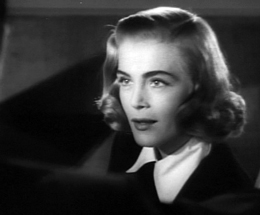
Pitfall proves to be as much about marriage as it is about sordid crime, and the script by Karl Kamb from Jay Dratler's novel re-frames the institution of marriage in very practical terms. Although unnoticed by most viewers, Elia Kazan's Boomerang! from the year previous uses Jane Wyatt as the particularly shallow spouse of a district attorney played by Dana Andrews. 1 Wyatt's housewife in Pitfall isn't as calculating but she does take an unusually pragmatic view of marital responsibility. (Spoilers) The finale shows a defeated John Forbes contrite, with Sue taking complete charge of their marriage. In one car ride the balance of domestic power shifts 180°. Sue is willing to forgive John "for the sake of her child" but she dictates the terms. The family will move to another town to protect their reputation and to keep Tommy from learning of his father's sins. John is definitely on probation; Sue will decide when their relationship will get back to normal, if ever. 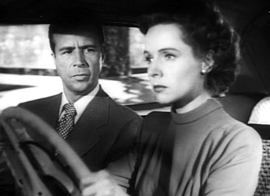
Compare that to the "soft landing" in the later 50s milepost The Man in the Gray Flannel Suit. Wife Jennifer Jones blows a fuse when she hears of her husband Gregory Peck's wartime affair, now ten years in the past. But she soon comes around to the humanist-moral position of supporting Peck's desire to provide for the child he left overseas. In Pitfall, John is morally culpable for Mona Stevens' grave legal problems. Nobody is going to help Mona; she's almost certainly going up for a long prison term. It's clear that John had better not as much as mention Mona's problems to Sue, or she'll have his head on a plate. We're left wondering what the future will hold. John wanted adventure, and will pay for it with a future of middle-class tyranny. Sue seems one of those women that trusts unconditionally until she's crossed, at which point trust vanishes forever. She will always have the upper hand in their relationship. As John's nature is to grouse and complain, how long will he last under Sue's disapproving looks? Will he seek forgiveness with other women? The outlook for 1950s America seems to be one of disillusion and divorce. Dick Powell's skill with hardboiled dialogue is entertaining in a noir vehicle like Cry Danger! but in Pitfall the cynical wisecracks are an essential part of his character. It's a relief to see the disenchanted John Forbes let down his guard and smile when he meets Mona. It's also heartening to see John Forbes reunited with his family, newly appreciative of what to most of the world is unattainable -- a loving home, a reasonably secure future. A few years of Sue's disapproving, accusing face will put an end to that dream. 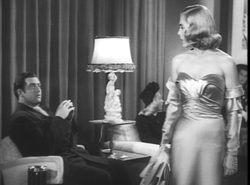
Lizabeth Scott is not everyone's favorite noir actress but she's perfect for Pitfall -- attractive and cheerful until the world seems intent on making her miserable. Scott is beautiful but looks neither cute nor innocent in the way that would win over a jury. Mona seems to know this as she takes the Brigid O'Shaugnessy walk at the film's conclusion. She's the consort of thieves and crooked ex-cops as well as the Other Woman, the enemy of the sacred American family. No sympathy there. This is also one of Raymond Burr's best pictures. His oily, covetous MacDonald shows no scruples whatsoever. MacDonald comes on to Mona like he's Robert Mitchum, too egotistical to realize that people call him "Gruesome" behind his back. In a strange pre-echo of Scotty Ferguson in Vertigo, MacDonald pretends to be a customer at The May Co. and obsessively forces Mona to follow his direction modeling a dress. MacDonald's just crazy enough to think that Mona will become his girl, even after he's arranged to have one of his competitors killed. 
An important sidebar issue concerns John's young boy, Tommy. He's played by Jimmy Hunt, the great child actor from Invaders from Mars. That science fiction film almost seems an extension of a scene in Pitfall. When little Tommy has nightmares his parents come to his room and lovingly settle him back down to bed again. John thinks he knows where his son's bad dreams come from when he discovers Tommy's stack of violent comic books about "men from space and torturing women". But John is wrong: Tommy's nightmares have the same source as John's own inner disturbances. The strange blend of surface tranquility and underlying insecurity in the postwar atomic age affects the adults, who pass it on to their children. Tommy's awareness of his father's negative attitudes makes him feel insecure. He wants his father to be an Alpha Male warrior like his friend's dad who won the Silver Star. The ray guns and woman-stranglers in the comics aren't to blame. John tells Tommy that everyone is like a camera, and that happiness comes from "only taking pictures of good things" so as not to be troubled by "bad pictures that come loose in the night and become nightmares". John's speech distills Pitfall's insight into the moral malaise of the 1950s. John and Sue Forbes are perfectly good people, but like most Americans they feel little sense of connection to any greater social responsibility. Sue will do her best to forget the "never to be mentioned again" Mona, and will encourage Tommy to ignore disturbing thoughts that might negatively affect his worldview. But as John already knows, the existential nightmares will still be there, insisting that something's not right ... 2 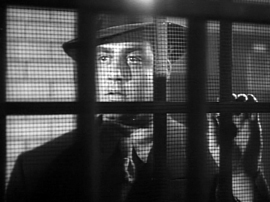
André De Toth's career wandered all over the genre map, and many of his movies have a genuine bite and a keen intelligence, as with the superior war film Play Dirty. There's not a wasted shot or facial expression in Pitfall. De Toth saves his stylistic touches for favored moments. The pathetic Bill Smiley is introduced through the mesh screen of a prison visiting room; both he and the loathsome MacDonald are 'abstracted' by the mesh, as if they were suffering from bad TV reception. De Toth's handling of the scenes in the Forbes household is exemplary. When John turns off the lights in anticipation of the arrival of Smiley, his home is transformed into a noir trap -- John must "hide" in his own living room like a burglar, backed up behind a bookcase. 3 Pitfall is one of those noirs that transports us back to Los Angeles in the years before freeways, when people still rode the Red Cars. Mona Stevens is seen outside The May Co. at Fairfax and Wilshire. It's now part of the County Museum of Art. John can park his car only few feet from the intersection; just try that now and see what happens. We also see him near the familiar city hall building. Apparently a line of pleasure boats were tied up at the Santa Monica Pier, which we see in detail; we also see the Santa Monica bluffs and notice the California Incline roadway later featured in It's a Mad, Mad, Mad, Mad World. The giant Pacific Ocean Park is also visible further down the beach in Venice. When John Forbes walks from his home all the way to work, we see the reflection of the Brown Derby sign in a store window, indicating that he's walking down Wilshire Blvd -- the wrong way? 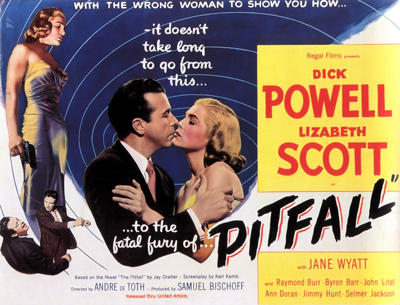
A UCLA restoration of Pitfall was released on videotape and laserdisc in the early 1990s; the VHS no longer shows up as an old item on Amazon. The film is yet another United Artists release that reverted back to its original owners. I hear of films like this being restored (Hollow Triumph a.k.a. The Scar is one) but then they don't seem to appear on disc or cable stations. Pitfall is a terrific gem in a modest package, a small thriller that outshines many more prestigious and well-known titles that have the good fortune to be owned and promoted by large studios. I hope that the promised new video delivery platforms will make films like it and the powerful Try and Get Me! more readily viewable.
On a scale of Excellent, Good, Fair, and Poor,
Pitfall rates:
Footnotes:
1. Wyatt's wife in Boomerang! engages in a crooked land deal with one of the film's villains. When her husband suggests that ethics may require that he forego their privileged lifestyle, the 'respectable' wife carefully sidesteps the issue. The look in her eyes tell us that she doesn't care who goes to jail, as long as she retains her money and her social position.
2. I've expended four or five paragraphs talking about what I think are the implications of Pitfall's final scene, which is probably less than two minutes long. I don't think that's critical overkill or that I'm reading anything into the film that isn't there; I believe these exact ideas were put there by great filmmakers.
3. Vincent Sherman used a similar and more horrific "prison visitor screen" visual the year before as the finale for his creepy noir Nora Prentiss. It's actor Kent Smith's best on-screen moment, scarred by plastic surgery and determined to die without revealing his true identity.
Reviews on the Savant main site have additional credits information and are often updated and annotated with reader input and graphics. Also, don't forget the 2009 Savant Wish List. T'was Ever Thus.
Review Staff | About DVD Talk | Newsletter Subscribe | Join DVD Talk Forum |
| ||||||||||||||||||